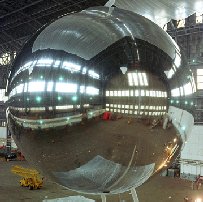|
| The Space Ball Project will create educational collaboration among primary and secondary school learners on an international scale. A unique feature of the project is an international focal activity: the design, launch and tracking of a highly visible satellite. The satellite will be big, dumb and cheap. Namely, it will be a highly reflective foam-filled balloon large enough to be visible at night with the unaided eye. It will be completely passive, unable to send or receive messages although its optical characteristics will be such that it will change colors and periodically create bright flashes. It will be inexpensive, using no new technologies. Primary and secondary school learners around the world will have control of the project in all phases. They will design the satellite and its orbit within the budget constraints of the supporting members. The learners will design tools and conduct experiments. Learners will develop a governance system within which to accomplish these activities. |
On its face, the Space Ball project is not about collaborative learning; it is about a satellite. The "collective ownership" of the satellite by the global primary and secondary school learner community will require the use of the Internet. It will also require the development of methods to govern large collaborative activities. It will incorporate smaller group activities. As local and global educational activities focus on the project, it will stimulate education in science, mathematics, engineering and technology. The Space Ball project may be tracked by a television network that will produce programs, coordinated with the Web portals, on the progress of the activity. The Space Ball project is international. Participation by primary and secondary learners any place in the world is welcome. Countries will participate according to their means and interests. Commercial enterprises will be welcome as sponsors. |
The Space Ball project will be funded internationally without significant co-mingling of funds. Each country—or other organization—will contribute according to its desires. Some of the contributions include:
- Internet portal(s) hosting
- TV series production
- Design, testing and fabrication of launch and demonstration satellites
- Satellite launch
- Shared simple instruments, tools, models, hardware, software, internet connections and simulations
- Administrative support
NASA has implemented a project that launched 3 balls covered with student-polished mirrors, Project Starshine: http://www.azinet.com/starshine/. The SpaceBall project was conceived without prior knowledge of this NASA effort. The Starshine project is no longer operating. You may find the European SkyWatch project of interest: http://www.sky-watch.org.
http://www.tomwason.com
+1 919.602.6370 (cell)
1421 Park Drive
Raleigh, NC 27605 USA
Copyright © 2001 - 2006 Thomas D. Wason
